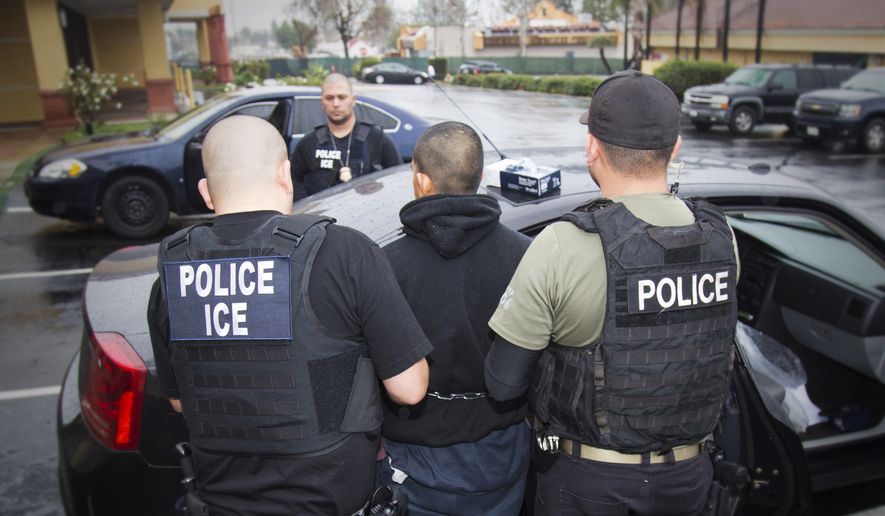The Supreme Court on Tuesday created a new deportation “loophole” for legal immigrants, ruling that the federal law mandating removal for those convicted of violent felonies is unconstitutionally “vague.”
Administration officials said the 5-4 decision will make it tougher to deport burglars convicted in California and child sex abusers convicted in New Jersey, based on the way those states’ laws are written.
President Trump said Congress must quickly step in and pass a new law cleaning up the confusion and making clear the government can oust people for those kinds of offenses.
“This is a public safety crisis that can only be fixed by Congress – House and Senate must quickly pass a legislative fix to ensure violent criminal aliens can be removed from our society,” the president said on Twitter.
Justice Neil M. Gorsuch — who sided with the four liberal-leaning justices in the ruling — explicitly left the door open to Congress to act, saying it should be up to lawmakers and not the courts to be explicit about the crimes that deserve automatic deportation for even legal immigrants.
“Congress might, for example, say that a conviction for any felony carrying a prison sentence of a specified length opens an alien to removal. Congress has done almost exactly this in other laws,” he wrote in a concurring opinion.
He and the liberal bloc said that if Congress wants to make legal immigrants deportable for lower-level felonies they can write those offenses into the law — but they can’t use a “vague” catch-all definition to cover any serious crimes they didn’t explicitly list.
Clearly violent crimes like murder or sexual assault are still deportable offenses. But as are burglary, arson and extortion, which were listed. But Congress transgressed when also included any other crime “that presents a serious potential risk of physical injury to another,” the court ruled.
“It was too hard to tell what would qualify as a violent felony,” Justice Elena Kagan, who wrote the controlling opinion, said from the bench as she announced the decision.
It’s not clear how widespread the effects of the ruling will be. Most deportations currently involve illegal immigrants who never had permission to be in the U.S., while Tuesday’s case deals with legal permanent residents who committed crimes while here.
Justice Kagan said she expects the government to use other parts of existing law to deport some of the people they used to deport under the violent felony statute.
But Chief Justice John G. Roberts Jr., writing the main dissent, said the effects could be “significant.”
Not only did the government say this section of law is “critical” for deporting “dangerous criminal aliens,” he said, but other parts of the criminal code use the same language — such as deciding who’s banned from possessing a firearm. If the law is too vague in the immigration context, it could also be too vague in the gun context, the chief justice suggested.
Justice Clarence Thomas went even further, saying the court was treading on dangerous ground by scouring the law books for badly written laws.
“I continue to doubt that our practice of striking down statutes as unconstitutionally vague is consistent with the original meaning of the Due Process Clause,” he wrote.
The case before the court involved James Dimaya, a citizen of the Philippines who was admitted to the U.S. as a lawful permanent resident in 1992. He notched two convictions for burglary, and the government decided to deport him.
The case first came to the high court a year ago, at a time when there were just eight justices, and they were evenly divided. Justice Gorsuch, who joined the court after the case was heard, asked for a rehearing so he could break the tie.
In his concurring opinion Tuesday he said people have a right to know what penalties follow from different criminal offenses. He said the language in the law describing risk of physical harm left too much power in the hands of judges.
“How, on that vast spectrum, is anyone supposed to locate the ordinary case and say whether it includes a substantial risk of physical force?” he wrote. “The truth is, no one knows.”
The difficulty is that state laws vary widely. A burglary charge in one state might envision threat of force, where in another state it wouldn’t. Judges are required to look back at the original cases to try to figure out whether the crimes rise to the level of deportability.
The administration said under the new ruling, drug traffickers in Florida or child abusers in New Jersey could avoid removal.
But immigrant-rights advocates said the ruling brought some standards to the law.
“Now, before deporting someone, including a lawful permanent resident, the government will have to prove that a ’crime of violence’ actually was violent,” said Jacinta Ma, director of policy at the National Immigration Forum. “This is a good step toward addressing problems with our immigration laws, but in the end, we need Congress to pass better laws.”
Indeed, both sides in the immigration debate have been demanding an overhaul of immigration laws for years. But they disagree on what it should look like, leaving a stalemate on Capitol Hill.
Tuesday’s ruling is the latest high court decision to throw hurdles to immigration enforcement. A 2001 case, known as the Zadvydas ruling, put a general six-month limit on how long people can be detained, forcing the government to release thousands of criminals back onto the streets each year when their home countries delay or refuse to accept them back.
Mr. Trump and top Homeland Security officials had already been pressing for Congress to fix that ruling.
• Stephen Dinan can be reached at sdinan@washingtontimes.com.




Please read our comment policy before commenting.